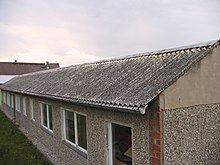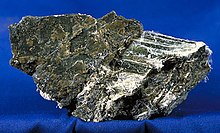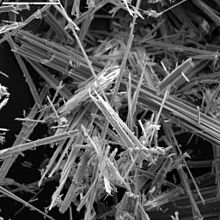Asbestos
Asbestos is a set of six silicate minerals which occur naturally. White asbestos makes up 95% of the asbestos found in buildings. It occurs in all parts of the world. It is fibrous, heat resistant and non flammable. These properties made it very attractive as a component in building materials and other products such as insulation and automobile brake pads. People have used asbestos throughout history. Ancient Egyptian people used asbestos. Asbestos is extremely dangerous for human health, as it can cause lung diseases such as asbestosis, emphysema and mesothelioma if the fibres get loose in the air and are breathed in. It can also harm animals such as livestock or pets.



The word "asbestos" comes from Greek, and means "inextinguishable". This refers to its use for wicks that would not burn.
Asbestos was linked to lung cancer in the early 1970s,[1] and was replaced by other materials in most applications by 1980.
Types of asbestos
changeThere are six types of asbestos:
- Chrysotile (white asbestos)
- Crocidolite (blue asbestos)
- Amosite (brown asbestos)
- Anthophyllite asbestos
- Tremolite asbestos
- Actinolite asbestos
All of these except chrysotile are part of the amphibole group of minerals.
Substitutes
change- Fiberglass - This is the most popular substitute. Fiberglass is physically similar to asbestos and its safety is also being questioned. Fiberglass has been called "man-made asbestos".
- Carbon fiber - Lighter weight than fiberglass or asbestos, but not heat resistant
- Wood fiber mixed with cement (in non-heat applications)
- Various polymer and plastic fibers
- Asbestos rope can be replaced with synthetic or fiberglass rope.
- Vermiculite insulation is a common substitute, although vermiculite itself can be contaminated with asbestos
- Basalt fiber is a mineral fiber with properties similar to asbestos. It is suitable for high-heat applications.
- Mineral wool is a common substitute that is popular in Europe
- Silica aerogel is the best insulator available. It is non-fibrous and is not believed to cause cancer if inhaled into the lungs.
- Asbestos siding or roofing can be replaced with aluminum or steel siding or roofing.
Disposal
changeSince asbestos is so resistant to heat, water, and chemicals, it is very difficult to destroy. It can be melted in a furnace to make a non-hazardous glass-like substance. This requires very high temperatures (1200°C or more) and consumes a lot of energy.
Lawsuits
changeMany companies that use or used to use asbestos have been sued by current or former employees who got sick with mesothelioma or asbestosis.[source?] Asbestos, especially tremolite, is also a contaminant in many other mineral products, such as talc and vermiculite. These contaminated products have also been the subject of lawsuits and product recalls.
Many lawyers specialize in asbestos-related lawsuits.
References
change- ↑ Burke, Bill (6 May 2001) "Shipyards, a Crucible for Tragedy: Part 1: How the war created a monster" Virginian-Pilot Norfolk, Virginia (newspaper)
Other websites
change- Cancer Resource Center Archived 2007-10-24 at the Wayback Machine
- Asbestos Institute